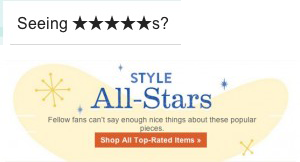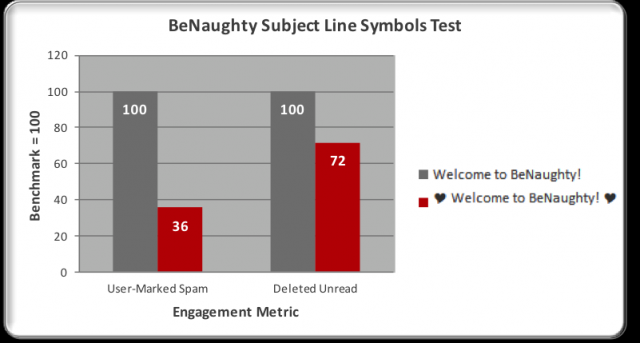Editor’s Note: This article was originally published by Web Marketing Today. Practical Ecommerce acquired Web Marketing Today in 2012. In 2016, we merged the two sites, leaving Practical Ecommerce as the successor.
You’ve probably seen special characters in email subject lines before — those interesting little symbols that show up now and again in your email inbox. They look like this.

How special characters appear in different email subject lines in an inbox.
These special characters go by many names: glyphs, ideographs, ideograms or sometimes, emoji. Most marketers just call them “special characters.” Whatever you call them, know that they’re not an image. Every one of them, from hearts to arrows, is just a symbol from the Unicode standard character set.
But do they work? Does using them in an email subject line increase opens, clicks, and other engagement metrics?
The answer is: sometimes.
There are pros and cons to using special characters in email subject lines. Generally, marketers report higher open rates. Some report better engagement, but many don’t. There are also reports of special characters causing problems with deliverability, mostly because spammers became very fond of special characters for a while.
The good news is creating them is very easy. There are a few resources on how to do that below. For now, let’s take a closer look at the evidence on whether you want to use them at all.
Special Character Subject Line Tests
Penton Marketing ran an email test of four different subject lines, each going to 1,500 subscribers. Here are the results:

Results from a four-way test of email subject lines. The subject line with special characters won.
In this test, the subject line with special characters clearly blew the doors off all competitors. It won on opens, clicks, and registrations.
Note how well the message and the special characters are aligned. One of the best practices with special characters is to use them where they make sense, not just for the sake of stuffing them in. The winning subject line here is a perfect example of using special characters to enforce the call to action. The medium — in this case, the characters — literally was the message. It wasn’t just text decoration.
Here’s another beautiful example of special characters delivering a message — literally.

A starry email subject line from online retailer ModCloth.
The email is from ModCloth and the example comes from Vertical Response.
This example actually breaks one of the “rules” of special characters: use them sparingly. The best practice is to use one special character per email subject line. At most, use two. But if you remember back to our prior example — the one with the 1, 2, 3 special characters — that also broke the no-more-than-two rule.
Bookended Special Characters
The use of stars here is also interesting. Quite a few retailers, like Think Fast Toys, Ulla Popken, and BBOS, use symbols, usually stars, at the beginning and the end of their subject lines. They’ve been doing it regularly over the last year, even as recently as last month. Typically, when they use stars, they put them before and after the text of the subject line. Several retailers have used this “bookending” with special characters over and over, so it’s probably working for them.
Look Beyond Open Rates
Bookended special characters definitely worked for BeNaughty.com, but in a different way. For them, special characters improved customer engagement. Fewer subscribers marked the message with the special characters as spam. More subscribers also read the email with special characters. According to Return Path, emails with special characters were also forwarded more.

BeNaughty’s test of special characters reduced spam complaints.
A travel company, Voyage Privé, saw similar results.

Voyage Privé also saw less spam reports for its message with special characters, and more people read the email.
Neither Voyage Privé nor BeNaughty disclosed exact open rates or click-throughs for these emails, but the data from their email campaigns shows it’s a good idea to look beyond open rates when you judge whether or not special characters have worked.
The Nudge Effect
Email marketers may see benefits from special characters — or any well-timed email message — whether a subscriber clicks or not. This is due to a phenomenon that Alchemy Worx, an email marketing firm, calls “The Nudge Effect.”
The nudge effect is when a customer sees an email message in her inbox, but does not click on it. She does not interact with the email at all, beyond reading the subject line. But fairly soon after — within 24 hours — she visits either the store or the website. In this case, the email has served basically as display advertising, except the customer saw the advertising in her inbox.
More Positive Reports for Special Characters
Other marketers have had positive results with special characters. Clickz reported a 15 percent increase in open rates with special characters. However, he has also cautioned that special characters’ novelty may wane over time, and the associated rise in open rates and other metrics may wane too. It’s certainly possible, and that may be why we see fewer special characters in our inboxes this month than we did last year. They may not be working as well, so marketers use them less.
But don’t give up on them yet. Several email service providers, like Experian’s CheetahMail, have reported specific, positive results from using special characters. Again, to be fair, almost every blog post about special characters has at least one comment where another marketer tested symbols and found them lacking.
CheetahMail got specific with its special character data.
- Subject lines with symbols had a higher unique open rate in 56 percent of brands we analyzed.
- The heart (♥) is the most popular symbol, but provided only a modest open rate lift of 2.2 percent.
- Of the 5 most popular symbols, the black sun with rays had the highest lift in open rates — 14.9 percent.
- Trying a different symbol may add a “wow” factor to subject lines. Airplanes (✈) had a 10.7 percent lift in unique open rates, while umbrellas (☂) generated a 50 percent lift.
A 50 percent lift from the umbrella symbol is incredible. Who knew? That little umbrella could be an email marketer’s secret weapon.
Mind your Email Clients
Before you send out your next email with special characters, make sure you test how the email looks in all the major clients. Tools like Email on Acid or Litmus are helpful.
You need to see your email on as many clients as possible because not all email clients render special characters the same way. Gmail, Hotmail, and Yahoo render special character reliably, but smartphones — iPhone, Android, and BlackBerry — don’t always show what you’d like. Remember, 48 percent of email opens are now on mobile devices.
Creating Special Characters for your Email Subject Lines
Creating special characters is actually very easy, but some experience with HTML might be helpful. Again, test how your email looks in every possible email client.
Here’s a list of pages with symbols and the code you’ll need to create them.
- Wikipedia — Miscellaneous Symbols
- Constant Contact — Add special characters to an email
- Campaign Monitor – Symbols
- Charbase — Visual Unicode Database
Test, and Test Again
As usual, the only way to know if special characters will work is to test them. Hopefully your list is big enough to let you send to two test segments, get a statistically valid result, and then mail to the rest of your list.
Most marketers will probably choose the simpler testing path:
- Split the list in two and mail both segments at the same time — one with special characters, one without;
- See which subject line does best;
- Try 2 to 3 tests like this with 2 to 3 different sets of subject lines, with and without special characters;
- Make an educated guess on whether symbols work for their list or not.
Have special characters worked for your email messages? Which specific symbols seem to perform best?



